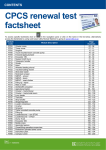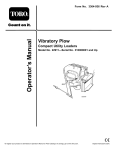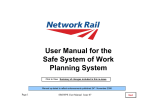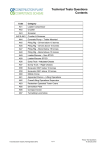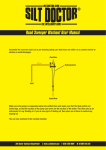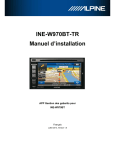Download RT36 - ACOP
Transcript
CPCS RENEWAL TEST FACTSHEET Lorry loader Note: It is recommended that you read the Supporting Information page before you read this factsheet. Preparation and completing work (Preparation) • Lorry loaders are by design, where used in or serving the construction sector, knuckle-boom loader-type cranes mounted on a road vehicle-based chassis and in principle limited to the loading and unloading of loads to and from the vehicle bed. The loader crane has the capability of slewing through 360 degrees and varying the working radius, and it is equipped with stabilisers for carrying out static lifting duties. They can be operated through various workstations, on either one or both sides of the vehicle while some versions can be operated remotely via a radiooperated unit. • Although the loader crane tends to be operated by the vehicle driver (operator) as part of their overall duties, accidents and incidents do occur. This factsheet aims to highlight some of the factors where incidents can and have occurred, and act as a reminder of safe lifting principles. • Proper pre-use checks are a requirement for the safe operation of any type of plant or vehicle and the operator is expected to undertake such checks at the required intervals. Failure to properly check all relevant components before work could lead to incidents or injuries because faults can affect both performance and safety. • The checks and inspections that need to be made are contained in the operator’s or user’s manual for both the vehicle and the crane, for which the operator needs to follow the relevant manufacturer’s instructions. If the operator notices any defect, they need to report it immediately before the vehicle or crane is used, with the appropriate expertise contacted who can decide when the vehicle or crane can be put to work. • An operator could incorrectly diagnose what they consider to be a minor fault, such as some chafing on one of the hydraulic hoses, whereas in fact it could be a severe fault possibly leading to the failure of the hose and crane. • The lifting accessories (gear) should be checked not only before but also after each lifting operation, as the accessory may have been damaged during use. • A requirement under legislation is the devising of a lift plan for the all the lifting operations that are to be carried out, as devised by the lift planner/appointed person. Amongst many factors, the lift plan should identify all risks, the measures to be taken to mitigate these risks, the weight and type of load, the type of lifting accessories (gear) that should be used for each load and the sequence of work that is required. • It is also important that the operator is informed of the plan’s contents and the actions required of them. If they notice that something in the plan is not correct or missing, they should immediately relay any concerns they have with the lift plan to their supervisor and if the lift plan needs amending, only the lift planner/appointed person is allowed to alter the lift plan. • Lorry loaders are equipped with stabilisers and before driving on the road, these need to be both in the transport position and locked, with any locking pins in place and secure prior to movement. Pedestrians have died when vehicle’s stabilisers have has slid out whilst driving along the public highway. Working safely and with others (Working safely) • Lifting operations involving lorry loaders take place in a variety of places, with many near or within areas with public access or movement. The area of lift and placing the load must be segregated from nearby pedestrians, who are normally oblivious to the dangers. • Lifting guidance states that wherever possible, the moving of a suspended load above other workers or pedestrians should firstly be avoided. Only where this is not possible can other measures such as netting around a load or additional securing or protection features then be considered. _____________________________________________________________________________________________________ © Construction Industry Training Board 2015 Page | 1 of 5 CPCS RT36 Factsheet 01-07-2015 CPCS RENEWAL TEST FACTSHEET • If delivering materials, due to possible movement in transit, the operator must check that the load will not shift or move before any load-restraining or securing gear is released. Severe injuries have occurred when loads have shifted unexpectedly after securing gear is released. • Conditions on site need to be taken into account before, during and after work. The lorry loader must be kept well clear of any overhead power lines. The boom must be kept well clear of any overhead power lines. Guidance issued by the energy networks utilities indicates what minimum distances must be kept from overhead power lines and the higher the voltage in the power line, the greater the distance that must be kept. This is to reduce the danger of arcing if the boom is close to but not actually touching the power line. If a load needs to be placed within the stated minimum distance, then the electricity distribution company needs to be contacted. • Because lorry loaders spend a significant amount of their working time travelling on the public highway, Road Traffic Act requirements need to be followed. Before joining the public highway, the overall height of the vehicle when it is in road transport configuration needs to be checked and noted. • Under the Road Traffic Act, the height of the vehicle when it is above 3 metres must be displayed clearly in the cab. Lorry loaders are further required to be fitted with a visual warning system to indicate to the driver if the loader crane is above a pre-set travelling height. • However, bridge strikes by a range of over-height vehicles are common. Traffic warning or prohibition signs on or near bridges show the maximum permitted vehicle height when the bridge is less than 16 foot 6 inches/5.03 metres high. Bridges with a full or partial arch tend to have goal posts or markers that the vehicle must be kept between. • Travelling in urban areas means that there is a risk of contact with vulnerable road users such as pedestrians and cyclists. Studies have shown that cycle-related incidents have occurred when at road junctions, the cyclist are positioned alongside the front nearside corner of the vehicle or just in front, after weaving through stationary traffic. They are situated in the driver’s potential blind spot and when the vehicle turns, accidents and fatalities have occurred. • Even if indicating, drivers must ensure that there are no pedestrians or cyclists alongside the vehicle before turning left or right, and if need be, wait until the cyclist or pedestrian has left the danger zone. Drivers must further scan all their mirrors wen approaching junctions in case cyclists or pedestrians enter the blind spots. Lifting and using attachments (Working tasks) • The loader crane should be equipped with some form of rated capacity indicator (RCI) which provides warnings to the operator when the loader crane both approaches and exceeds maximum rated capacity for the configuration. • Some RCIs can be overridden or adjusted but this is purely for diagnostic and testing purposes during the maintenance programme and they must never be overridden by anyone during lifting operations; otherwise overlifting could risk the crane overturning. • The weight of a load needs to be established or calculated before it is lifted, and checked that it is within the lorry loader’s maximum rated lifting capacity. This is predetermined by the loader crane manufacturer and is dependent on a set configuration, including the operating radius. • The operating radius is defined as the measured horizontal distance from the crane’s slew centre to the centre of the hook. The rated capacity is the total weight that can be lifted and operators need to be aware that the total weight being lifted will include the weight of the load, any packing or packaging, the weight of the lifting accessory or accessories and any attachments still fitted e.g. a bucket. • The rated capacity of a crane only applies to a freely suspended load, and does not apply at all times or for all situations. For example, if a load is still attached to a structure, vehicle etc. or embedded in the ground, the increased resistance when being lifted can overload the crane. • The weight of any load is, in principle, determined by its size and density – for example, a pack of house bricks will be heavier than a same-sized pack of aerated breeze-type blocks – meaning that operators can’t estimate the weight by shape, height, width and length alone. If the weight is not known, it should be established before it is lifted. _____________________________________________________________________________________________________ © Construction Industry Training Board 2015 Page | 2 of 5 CPCS RT36 Factsheet 01-07-2015 CPCS RENEWAL TEST FACTSHEET • Operators need to be aware that loads can be heavier than the weight indicated on the load or associated tare sheet. If, for example, they are of a porous material such as sand, or covered in packaging that has soaked up water, the load can be heavier than marked. • The handling of loads requires care particularly where varying loads are lifted and placed; for example, to prevent loads with sharp edges damaging lifting accessories such as fibre slings, the operator should apply a packing material between the accessories and the load. • Where a load is being attached using a two-legged chain sling, the operator need to understand the safe working load of each lifting accessory and what might happen if an accessory is used beyond prescribed limits. For example, if a two-legged chain sling is lifting a load of 4 tonnes with each leg vertical, the load in each leg is half of the total and in this case, 2 tonnes. • If the (included) leg angles are increased beyond 90 degrees, the load in each leg is increased to 4 tonnes. Therefore multi-legged chain slings should not be used beyond an (included) angle of 90 degrees as they could be overloaded. • All loads should be lifted vertically. This means that the hook of the crane must be placed directly above the centre of gravity for the load, not the centre of the load. Depending on the load, the measured centre of the load and the centre of gravity of the load (the point that it is in balance) is not always at the same place. • If the hook is offset to the centre of gravity of the load, it can drag along the ground when it is at the point of lift and an overload situation can occur if the load snags whilst being dragged. • Lifting regulations indicate that where the operator cannot see the full path of the load (if, for example, it is being placed behind a wall), then a signaller is required to assist the lifting operation. Before the lift is undertaken, the operator and signaller need to ensure that a code of signals is understood and agreed. Stability • Due to the various factors mentioned, lorry loaders have become unstable and overturned, with the usual costly consequences. Effective planning of the ground, working area and other environmental factors must be taken into account before setting up begins. • Lorry loaders generally can only lift loads when the vehicle is level both longitudinally (forward/backward) and laterally (sideways). Where the loader crane is not level e.g. on sloping ground, the radius for the load may increase and exceed the safe maximum, especially where it is close to the rated capacity, and this may make the crane and vehicle unstable. • Ground conditions naturally play an important part in stability and these should be established by a suitable and competent person to ensure that the ground can support the bearing pressure applied through each stabiliser for all expected loads and configurations. • Ground conditions are crucial for maintaining stable operations. The operator needs to take into account changes to the ground, such as after heavy rain which can weaken the ground and cause one or more of the stabilisers to sink. • The weight applied by the pad of a stabiliser is at its greatest when the boom of the loader crane is directly over the leg and the heavier the load at the maximum permissible radius means additional loading through the leg. • Ground-bearing pressure can be reduced through each outrigger by using spreader or support mats which spreads the applied pressure. The larger the mat, then in principle the greater the reduction in applied pressure. The minimum size of a mat should be determined by an appropriate expert. • As some of the stability is dependent on the weight of the host vehicle, the least stable state, or the point which instability is more likely to occur, is when the vehicle has no loads on its carrying platform or bed. • In certain locations, the limited size of the loading and unloading area may mean that the stabilisers cannot be fully extended. Operators therefore have not or only partially extended them with the result that the vehicle becomes less stable. Investigations have shown that a common cause of vehicle overturns is when operators have not, or only partially, extended stabilisers. • Loader crane manufacturers provide guidance on when partial extensions of the stabilisers can take place. This guidance must be followed at all times and partial extension must not occur unless approved by a suitably qualified and authorised person. _____________________________________________________________________________________________________ © Construction Industry Training Board 2015 Page | 3 of 5 CPCS RT36 Factsheet 01-07-2015 CPCS RENEWAL TEST FACTSHEET Sample questions The following questions are based on the text within this factsheet and indicate how the questions and answers are structured. Based on the factsheet, there is only one correct answer. The correct answer to each question is indicated at the end of this factsheet. Q1. What final check should be made on completion of work but before driving off a site? A That the stabiliser legs are fully retracted and locked B That the tyre pressures have been adjusted for any additional weight C That the steering system fully functions D That any rotating flashing beacons have been switched off Q2. How can rain affect the weight of materials such as blocks and sand? A There would be no effect on the lift B The load would be less stable C The weight could be heavier than that marked D The weight may be lighter but less dense _____________________________________________________________________________________________________ © Construction Industry Training Board 2015 Page | 4 of 5 CPCS RT36 Factsheet 01-07-2015 CPCS RENEWAL TEST FACTSHEET Study checklist This checklist aims to act as a study aid to ensure that the reader has identified and understood the relevant parts of this factsheet. Do you know? 1. Why should faults, even those considered minor by the operator, be checked by an expert before use. 2. Why lifting components and accessories should be checked after use. 3. What the purpose is of a lift plan and who can construct the plan. 4. The reason for ensuring that the stabilisers are locked into the transport position before travelling on the road. 5. Why any lifting operations must be segregated from those nearby. 6. The reasons for having minimum distances that have to be kept from nearby overhead power lines. 7. What the requirements are to prevent the lorry loader from striking low bridges. 8. How and when low bridges are signed. 9. What the purpose is of the rated capacity indicator. 10. Why the weight of each load to be lifted must be known and how it can be established. 11. What determines the rating capacity of the loader crane and when it applies. 12. What constitutes the total weight that is to be lifted by the loader crane. 13. What can cause instability of the lorry loader. 14. How wet weather can affect the weight of a load to be lifted. 15. Why the hook of the crane must be above the centre of gravity of a load. 16. When a signaller would be required. 17. How ground conditions can affect safe lifting operations. 18. What the effect could be if stabilisers are only partially extended. Answers to sample questions: Q1: A and Q2: C _____________________________________________________________________________________________________ © Construction Industry Training Board 2015 Page | 5 of 5 CPCS RT36 Factsheet 01-07-2015









